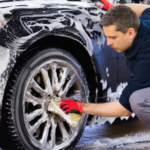In the last decade or so, podcasts have exploded in popularity, and they show no sign of slowing down. Over 40% of Americans listen to some form of podcast at least once per month.
This means that there’s a potentially huge audience out there if you were to produce one. It also means that there’s a lot of competition out there as well. If you want to stand out, you’ll need to produce something truly exceptional.
One of the surest ways to have people give up on your podcast is to have poor podcast audio. So what does a podcast producer need to know about editing speech and podcast production?
This article tells you everything you need to know about podcast audio.
- Record Good Quality Audio
While editing podcasts is certainly important, you shouldn’t need to rely on it too much. Ideally, you’ll have audio that is so well recorded that you won’t need to spend much time at all in your editing programs.
Click here – 7 Tips to Gain More Organic YouTube Views and Go Viral
Editing should be mostly spent adding things like jingles or cutting out superfluous sections. You shouldn’t be spending most of your time editing out pops, crackles, and other audio artifacts.
You can eliminate a lot of the need for these kinds of edits by investing in high-quality microphones. You should also make sure you use good quality cables as well.
Doing this will significantly reduce the amount of undesirable noise that needs to be edited out.
- Use Dynamic Range Compression
Let’s say you’re doing a podcast interview and one of the guests has a tendency to go from talking in whisper-like tones but then gets quite loud when he gets excited.
This is difficult to listen to as you’ll feel you need to turn up the volume to hear, and then when the guest shouts, the volume will be painfully loud. Some amateur podcast editors would raise the volume of the quiet sections and then lower it when the guest shouts.
If you ever do this kind of editing, you’re wasting your time. You should use something called a compressor to fix this kind of issue. A compressor essentially lowers the dynamic range of a sound. Basically, it makes the quiet parts louder and the loud parts quieter.
This means there’s no need to do painstaking edits when it comes to volume discrepancies. You can just throw a compressor on the offending channel, dial in some settings, and then the volume becomes perfectly balanced.
- See the Waveform
You should use audio editing software that allows you to zoom in on audio waveforms. Of course, you should mostly rely on your ears, but looking closely at the audio waveforms in your editing software can reveal things about the audio you might not be able to hear.
For example, your microphone could record incredibly low tones that your monitoring speakers are not capable of replicating. Low tones have an incredible amount of sonic energy, so if you run them through things like compressors, it can make them react differently to what you want for a podcast.
Looking at the audio waveforms can help you identify problematic sounds that you might not have noticed otherwise. It can also help you to do much more precise editing.
Click here – Offbeat Jewellery Trends This Season
- Know Your Software Shortcuts
Don’t underestimate the power of learning the software shortcuts for your audio editing software. Of course, most people know the basics, such as CTRL+Z, to undo, but there are also hundreds more useful shortcuts for you to use.
If you want to make a successful podcast, you need to quickly turn around new, high-quality episodes. If you’re editing mostly using the mouse, you’re not working efficiently.
Take the time to learn all of the software shortcuts, and you’ll be able to edit much more efficiently and effectively. If you need a speedy turnaround time, you might want to hire an audio editor rather than do it yourself.
- Reduce Sibilance
Sibilance is the hissy high pitched sound created when you say words counting “sh,” “th,” “f,” “z,” and “v” sounds. This can be incredibly fatiguing and unpleasant to listen to. This means that it’s essential that you take measures to reduce it on your podcast.
The best way to do this is through the recording process. You should use something like a pop filter on your microphones. This can do a lot to reduce sibilance. Using a high-quality microphone without any kind of filter is ill-advised as it’s likely to produce a lot of unwanted sibilant tones.
Of course, sometimes you might end up with recorded audio that is too sibilant. Going back in time and re-recording it isn’t an option, so you’ll need to fix it in editing.
You can use an audio plugin called a “de-esser.” A de-esser identifies high-frequency sibilance and removes it from the recording.
- Don’t Overdo It
A good podcast recording should sound natural. You should approach it as trying to capture the natural sound of the room and the speakers. You should only apply audio plugins to fix specific problems with the recording.
In an ideal situation, you won’t need to use any audio plugins at all to edit your podcast. You should be very careful of applying things like compression, equalization, or de-essing to audio. Excessive use of these kinds of plugins can make your audio sound unnatural.
In fact, you shouldn’t really need to use much equalization or de-essing at all for podcast audio. If you need to use these regularly, it suggests that your microphones are not up to standard.
Get Great Podcast Audio With These Editing Tips
If you want to create a successful podcast, you need to have good quality podcast audio, and you need to be able to produce it to a schedule. The best way to achieve natural, good quality sounds is to record them correctly with the right kind of microphones.
If you need to use a lot of audio plugins or do many edits, it suggests that there might be a problem with your recording setup. If you want to consistently put out audio of the highest quality, consider hiring a professional audio engineer and audio editor.
If you want to read about other interesting topics, look at some of our other articles.






